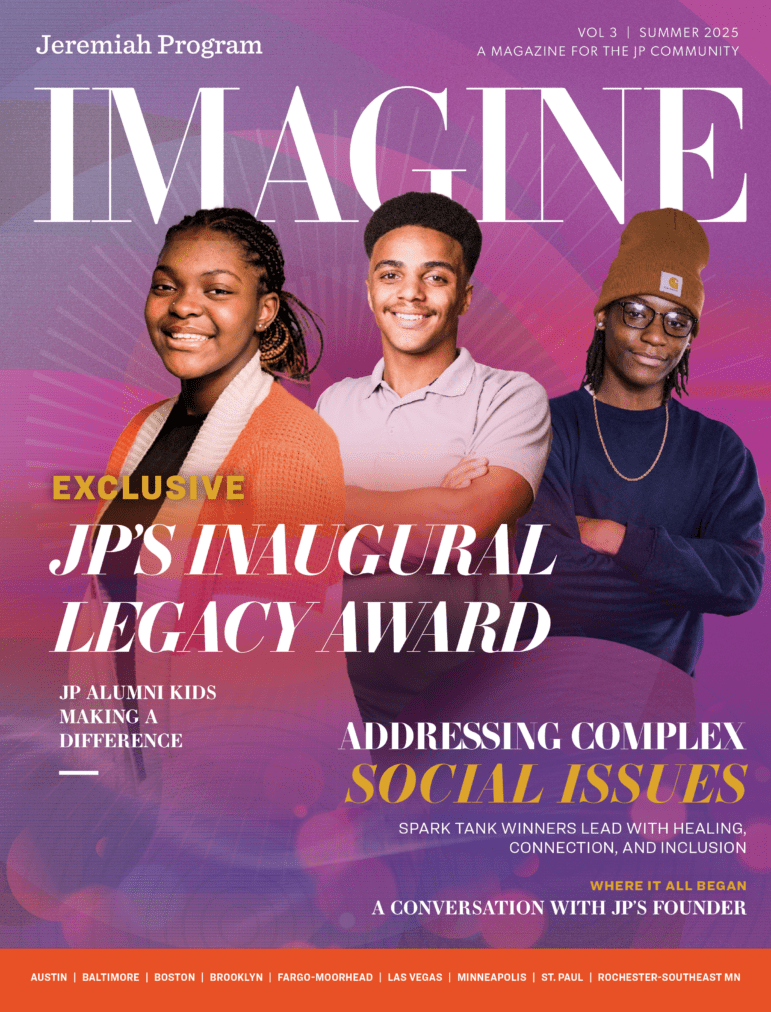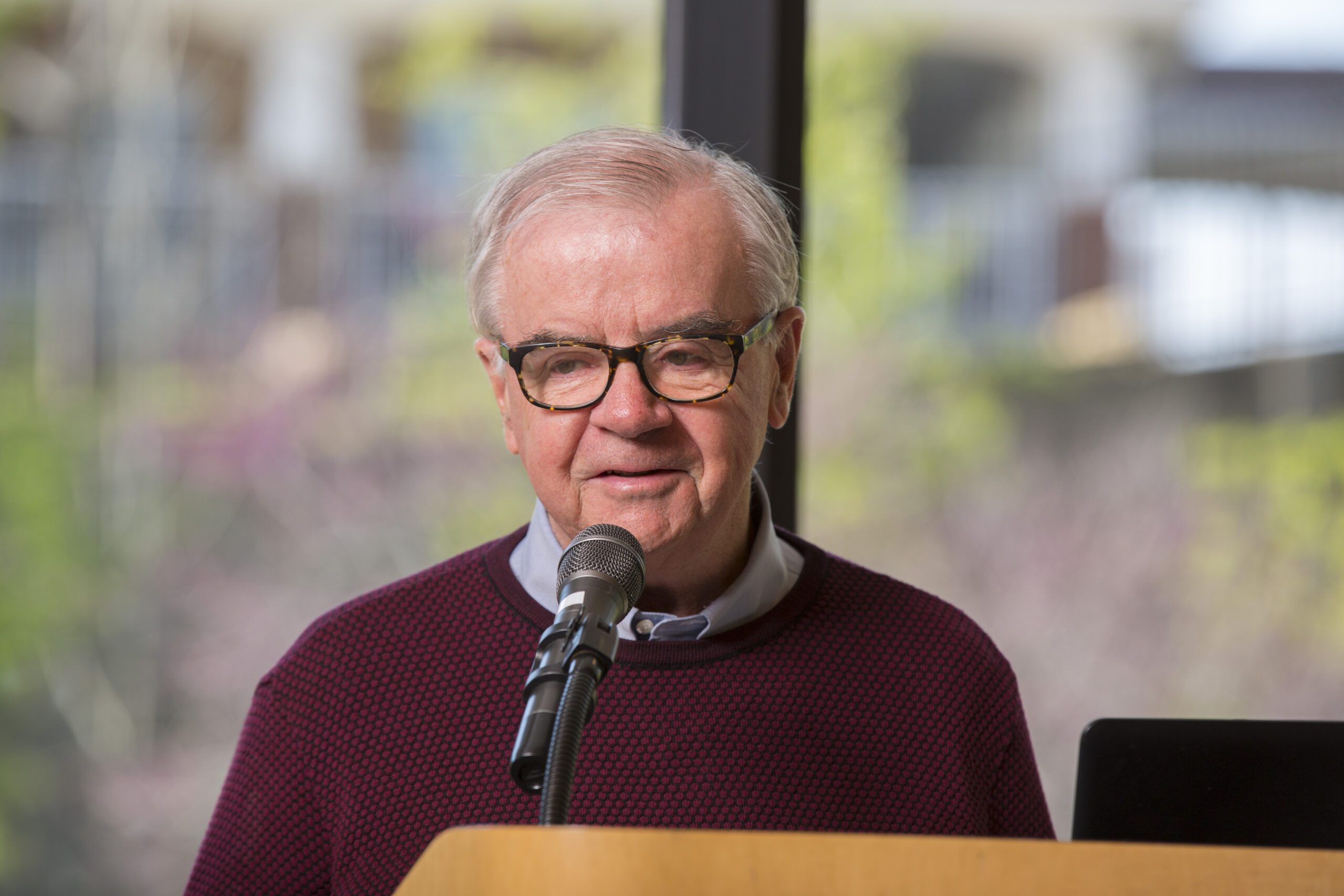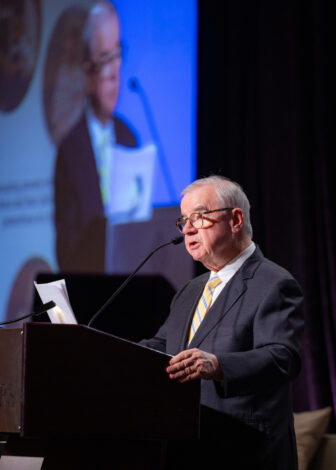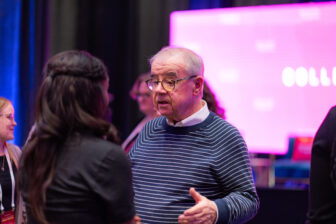How One Vision Sparked a Movement
JP founder Michael O’Connell discusses the program’s beginnings and what excites him about the future.
Over 30 years ago, when Michael O’Connell first felt stirrings of the idea that would become Jeremiah Program, he never could have imagined that it would grow into a national organization serving thousands of families.
He witnessed the success of the seeds he planted when he attended the 2025 JP Summit Weekend in Minnesota — his first JP Summit experience. “There were over 400 people, and about 350 of them were in the program or graduates,” he reflected. “I had never seen, much less experienced, so many graduates, and I just have to tell you it was overwhelming.”
Michael also makes it a point to recognize JP as a community endeavor. “As the vision developed,” he explained, “volunteers from churches, synagogues, businesses, corporations, foundations, schools, government, and neighborhoods became involved and supported the vision that would benefit the entire community.”
Michael recently sat down with JP staff and shared some of his favorite JP memories. He also discussed what excites him about the program’s present and future.
Note: This interview has been edited for length and clarity.
What do you remember about the initial vision for Jeremiah Program?
The idea started in the fall of 1991, and I had just become pastor of the Basilica of Saint Mary in Minneapolis. That first week, maybe the second week in September, the idea started to creep into my brain. It was not until New Year’s Eve 1997 that the first six families moved in.
I will never forget that I had the privilege to escort Penny and her 3-year-old son Avery to their apartment in the original 18-unit building.
We walked into this brand-new, two-bedroom corner apartment that overlooked two interstate highways; you could see out of two sides. Avery went in, ran to the window, and climbed up on a little chair. He looked back and forth, back and forth, back and forth, and yelled over his shoulder, “Mom! Look at all the trucks!”
That may sound kind of corny, but it confirmed for me that we were onto something.
What circumstances led to the vision for JP?
St. Mark’s Episcopal Cathedral, located across Loring Park from the Basilica, invited me to join the board of a program called Students with Children. The program provided day care during the week for mothers who attended the community college or technical college that was close by.
Women enrolled their children in the day care program when school began that fall, but a high percentage of them had to drop out. The majority of them never even made it through the first semester: Of the 30 original families that started in September, only six families remained in December.
To find out why they dropped out, we put together focus groups of women who had children and went to the community or technical college. We had a nice dinner for them and their kids, looked after their kids, and said to them, “Dream about what a program to help you complete your academic goals would look like. What would be in it?”
“Two generations are going to go through and be successful in the world because they had the opportunity of a great education.”
It’s amazing how each of the groups was relatively the same in terms of what they had to say. The main issue was safety: “Could our lives be safer to help us stay in the program?” That was a biggie.
I asked them, “What could go wrong that would stop your pursuit of your academic program?” Some of their responses were safety, access to transportation, the health of the mom, the health of the child, unhealthy relationships, and lack of support. Any one of these realities and many others stopped them in their tracks. What we learned from those focus groups was key to the vision that became Jeremiah Program.
The women had no support group around them, and they dropped out of school for a myriad of reasons. We began to think about those day-to-day realities, those inevitable things that could happen and yank them right out of the program. We had to figure out what was necessary to care for the children in a safe environment, handle illness, or fix a car. What would it take to remove the barriers to their success? It was an aha moment.
What’s another favorite story from JP’s early days?
We finally figured out that we had to create the equivalent of a dorm. That was key. Why? Well, that’s where a woman will be safe, especially if she can manage it well, get everything she needs, and have her child receive early childhood education. So we now knew that we needed a safe and secure place for women and their children to live and be successful.
In 1993, as the JP vision was evolving, the roof of the Basilica was being restored. There was a crane with a bucket to bring workers to the top. Jim Howard, the CEO of Northern States Power — now it’s Xcel Energy — came for breakfast one morning, and he was telling me that his company really wanted to get behind affordable housing. And I said, “That’s great!”
The bucket was going up and down outside the window, and Jim said he worked for a power company when he was in college. I asked him if he wanted to take a ride. He said he did, so we rode the bucket up 150 feet to the cross at the top. The wind was blowing, and Jim had his arm over the arm of the cross to steady the bucket so we wouldn’t blow away.
I said, “Jim, you see that parking lot down there? You own it.” He said, “What do you mean I own it?” I said, “Northern States Power owns it, but you don’t use it anymore. The Basilica uses it on Sundays for parking. I want to thank you for that.”
Then I said, “You and I have been talking about this Jeremiah idea. That is where the ‘dorm’ needs to be — in that parking lot.” Jim, with his arm over the cross, said, “But I’m a Presbyterian!” And I said, “That’s OK. It’ll still work.”
And a month later, we had a half-million-dollar piece of property.
As JP’s founder, what is your reaction to the new JP Legacy Award? How do you see it connecting to your original vision for the program?
The vision for Jeremiah Program was always to benefit two generations. The necessity for an education to provide opportunity was the key to enjoying an independent life. From the beginning, the moms understood that graduating from high school or having a GED was not enough. They knew that continuing your education was the mechanism to get on the path to success.
Their children have really seen and understood how important education is to their own future by watching their mothers succeed. The children understand the importance of post-secondary education, and for many, it’s really important to have a scholarship to achieve that goal. They are motivated to apply for the Legacy Award to enable them to pursue the education they want for themselves.
This completes the original vision of Jeremiah to provide a future full of hope, two generations at a time. Two generations are going to go through and be successful in the world because they had the opportunity of a great education.
What hopes do you have for Jeremiah Program’s future?
Well, it’s always puzzled me that, as far as I know, what we’re trying to do is still a one-off. There are no other two-generation programs like this for a specific group of people like high school graduates, who know they need to have post-secondary education.
So my hope for the future is that we keep growing in a smart way. That’s important. I have great respect for the people at the national level who are guiding JP into the future. What I understand is that, yes, it is successful in nine places around the country, but JP’s leaders are going to be thoughtful about further expansion. In other words, being very careful. And so that’s what my hope is, that it will keep expanding.
Another hope would be that others will figure out models of it, ways to do the same thing in a different way — because if you take any of these women who have graduated from high school and want to go to college or post-secondary, you have winners. A mom who has chosen that path has the capacity and the agency to succeed. She arrives that way. Once she discovers that, with the sisterhood’s support for her and her child, she can visualize her own success, and it’s a winner.
Is there anything else you want to say about Jeremiah Program — past, present, or future — from your perspective as founder?
My faith has taught me that something that seemed to be impossible could be possible. You can wake up one morning and say, “Well, where did this come from?” The answer is, “It doesn’t matter.” It comes from God. I was in the right place at the right time and was able to gather many people who shared the vision in theory. Only through commitment, tenacity, perseverance, and tremendous generosity were we able to work together to bring the vision to reality.

Find this story and more in our magazine, Imagine!
We believe a Jeremiah Program mom dreams in threes: for herself, her children, and her community. In essence, the investments she pours into herself and her children leave a legacy that lasts generations. The third issue of Imagine explores the power of this three-fold, collective dreaming.
Did Michael’s story resonate with you? A monthly gift goes further to support JP families.



